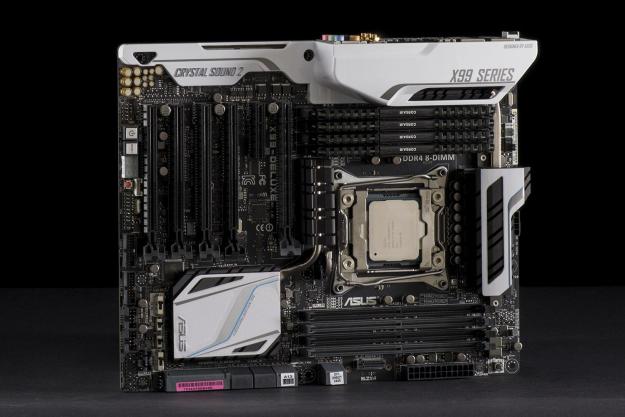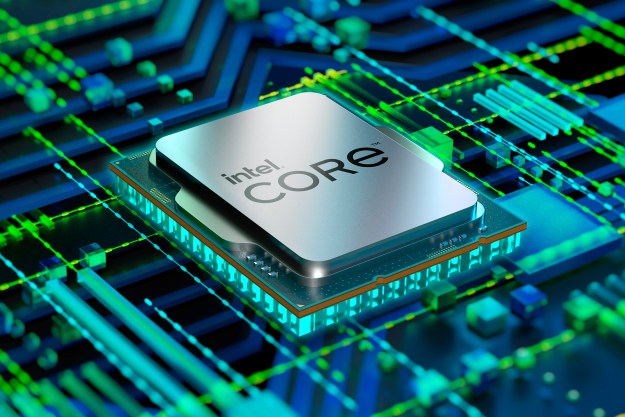
“The Core i7-5960X is the most powerful consumer processor ever. It's so quick, in fact, that it's overkill even for most enthusiasts.”
- Amazing multi-core performance
- X99 platform offers excellent connectivity
- Surprisingly efficient
- Very expensive
- Not compatible with previous LGA2011 sockets
- Doesn't work with DDR3 RAM
Time flies, doesn’t it? While it still feels relatively fresh, Intel’s Haswell architecture is now more than year old. Its replacement, which is code-named Broadwell, is being prepared for release this holiday season. Soon, Haswell will be old news, replaced by even more efficient hardware that will likely outperform its predecessor by every metric. This relentless march forward has become Intel’s signature style, and delivers a regular burst of excitement to the stagnant PC market.
Before Haswell goes away, however, Intel has decided to let it have one last hurrah in the form of Haswell-E. This new line of processors offers six to eight cores, and is launching alongside the X99 platform, which is the first ever to support DDR4 RAM. The star of the show is the Core i7-5960X processor, an eight-core behemoth clocked at 3 GHz.
Such extreme hardware is sure to make enthusiasts salivate but, as usual, Intel’s quickest Extreme Edition comes with an equally extreme price of $999.
How much performance can a grand buy you?
Same old architecture
From a technical perspective, the Core i7-5960X is the least exciting component of this launch. Though it manages to provide eight cores, which is a first for any Intel processor (previous Extreme Editions maxed out at six), it does so without any fancy footwork. Intel has simply added more Haswell cores, and slapped on more cache (20MB, split between all cores) to match.
Of course, fitting this many cores onto a chip requires more space, and the 5960X is physically larger as a result. This means it works only in LGA2011 sockets. In fact, it will work only in the new LGA2011-v3 socket. Owners of older LGA2011 motherboards are out of luck.

That will disappoint some enthusiasts. The technical reasons for this are understandable; the new X99 platform offers several advancements that are incompatible with earlier technology, which we’ll soon address. However, it’s disappointing that owners of older six-core Extreme Edition chips have been locked out of an upgrade path.
In addition to eight cores, the 5960X of course offers two of Intel’s two signature features; Hyper-Threading, and Turbo Boost. Hyper-Threading, which processes two logical threads on a single physical core, lets the 5960X handle a whopping 16 threads at once. Turbo Boost, meanwhile, can automatically overclock the processor to a default maximum of 3.5 GHz (500 MHz above the base clock) when thermal conditions allow, and the workload demands it. All of the CPU cores are unlocked too, so enthusiasts can manually overclock the 5960X to even higher speeds.
One thing this processor doesn’t include is integrated graphics. This is not odd for a high-end Intel chip, but it’s worth mentioning because it can surprise people who are new to enthusiast hardware. Every Haswell-E desktop needs a dedicated graphics card.
Exciting new platform
While the processor itself offers few surprises, the new X99 platform is a different story. As Intel’s latest flagship platform, it offers a buffet of features, some of which are firsts. While releasing a radically revised platform may seem odd with Broadwell right around the corner, Intel has indicated that it will launch with mobile chips, then follow up with desktop parts. X99 will likely be Intel’s latest-and-greatest until the spring of 2015.
Anyone editing video at 4K will benefit immensely from the power put forward by Intel’s newest CPU.
The big story is support for DDR4 RAM. Everyone needs memory, of course; the quicker is better. This is a big win for anyone running large, complex programs. For this niche, the fact that X99 supports DDR4 with speeds up to 2133 MHz across four channels may prove to be important. It makes sense that Intel would release DDR4 first on an expensive platform meant for expensive processors, as buyers interested in such chips are those most likely to be interested in quicker RAM.
DDR4 isn’t entirely a boon, however, as there are several problems. Like all new technologies, it comes with a hefty early adopter tax. Four sticks of DDR4 memory totaling 16GB (that’s four per stick) will set you back well over $200.
That’s about three times more than equivalent DDR3 memory. X99 also supports speeds only up to 2133 MHz, which is lower than the standard’s maximum. Owners of this platform won’t be able to use the quickest DDR4 RAM available.
Another point of contention is the LGA2011-v3 socket. This socket provides no backwards compatibility at all. Haswell-E processors will not work in older motherboards, and X99 motherboards with LGA2011-v3 won’t accept older processors. This is an intimidating barrier to entry.
While the features mentioned so far have pros and cons, there are some indisputable wins. One is the inclusion of support for up to 40 third-generation PCI Express lanes. This lets the X99 platform run two video cards at full 16x speed, and a third at 8x speeds. Up to five PCIe cards can be installed in total, all at 8x speed, but this is possible only with specific motherboards that enable it with third-party hardware. Most motherboards will max out at four discrete cards, which is still quite impressive.
Note that only the 5960X and 5930K offer this regardless of the motherboard they’re paired with. The entry-level 5820K only has 28 PCI Express 3.0 lanes, and can devote a full 16 lanes to only a single video card.
The Intel Core i7-5960X pushes the bleeding edge of desktop performance forward.
There’s also a wealth of room for connectivity, including up to six USB 3.0 ports, up to eight USB 2.0 ports, up to 10 SATA 3.0 ports, and support for multiple Gigabit Ethernet connections along with integrated Wi-Fi. A total of eight PCI Express 2.0 slots can be provided, and Intel’s Rapid Storage Technology is available, though support for this feature is entirely optional (meaning some motherboards will not support it). The same can be said of Thunderbolt 2, which is available, but not mandatory.
No one can argue that X99 isn’t sufficiently advanced. The real question is whether it’s too advanced for its own good. Using DDR4 alone, rather than including backwards compatibility with DDR3, makes the overall cost of a Haswell-E desktop extremely high. You can expect to spend at least $500 on the motherboard and RAM alone, and some combinations of the two could exceed $1,000. Pricing will come down over time, of course, but X99’s early adopter tax is particularly harsh.
Benchmarks
Now that we’ve gone over the details with a fine-toothed comb, let’s move on to the main event; the benchmarks. As complex as they are, processors are really quite simple to judge; it’s (almost) all about performance. We tested the Intel Core i7-5960X using an ASUS X99-Deluxe motherboard.
Let’s start with SiSoft Sandra’s Processor Arithmetic benchmark. This test makes good use of multiple cores, but doesn’t excessively prefer them. This makes it a nice, balanced gauge of overall speed. We’re also including the Core i7-4960X, the Core i7-4970K, the Core i7-4770K (at its default clock), and the Core i5-4590 for comparison’s sake.
These scores make a strong case for the 5960X, which blows away the six-core 4960X by achieving a score that’s over 60 points higher. In addition, the 5960X almost doubles the i7-4770K, more than doubles the i7-4970K, and nearly triples the i5-4590. The Intel Core i7-5960X offers incredible performance.
7-Zip told the same story, delivering a score of 39,431. That easily beats the 4960X’s score of 32,992, and trounces the 4970K’s and 4770K’s respective scores of 24,249 and 22,042. The i5-4590 is left far behind, obtaining a result of just 15,841.

Geekbench produced a single-core score of 3,308, and a multi-core mark of 23,216. The latter easily whips the 4770K’s multi-core result of 13,527, but the single core figure is actually behind the 4770K’s grade of 3,587. The newer 4790K “Devil’s Canyon” chip also did well, managing a single-core score of 4,079, and a multi-core number of 15,058. This means applications that aren’t optimized for multiple threads won’t benefit from the 5960X.
We also fired up Cinebench R15, a synthetic test that emulates a demanding image rendering workload. In this benchmark, the Core i7-5960X scored 1,329. This again annihilates the 4770K, which scored 749, and the 4970K, which got 702. Intel’s quad-core CPUs can’t hope to match a processor with double the number of cores.
Quick and efficient
We hooked up the 5960X and the X99 motherboard up to our wattmeter. We noted idle power draw of 74.6 watts, and load draw of 156.9 watts. An Nvidia GT 650 video card was also installed. These figures are much higher than a typical Intel quad core CPU, but are still solid given the platform’s impressive performance. Falcon Northwest’s Talon, which we reviewed earlier this year, was equipped with an overclocked Core i7-4770K, and consumed only ten watts less.
Conclusion
The Intel Core i7-5960X pushes the bleeding edge of desktop performance forward. In our tests, we found it to be up to 43 percent quicker than the six-core 4960X, Intel’s previous Extreme Edition chip, and up to 77 percent faster than the 4770K quad-core.
Unsurprisingly, Intel’s newest chip achieves its greatest victories in tests which are reliant on multi-threaded performance, like the 7-Zip compression benchmark. In Geekbench’s single-core test, the 5960X’s relatively low clock speed puts it behind some of Intel’s old quad-cores. This is worth noting, but shouldn’t be terribly important, as we can’t think of a demanding application that’s not coded for multiple threads.
While the 5960X is impressive, its incredible performance is gated behind a barrier of Benjamins, Jacksons and Washingtons. The total cost of a 5960X, motherboard, and RAM will exceed $1,500 at a minimum, and may reach well above $2,000 for buyers who need an extravagant motherboard or 32GBs of memory. Such costs will be difficult for many enthusiasts to justify. Even gamers will find this processor to be overkill.
The 5960X and its platform, X99, are exciting, but they’re not meant for play. This is serious hardware that only makes sense for people and organizations that need truly extreme performance. Anyone editing video at 4K will benefit immensely from the power put forward by Intel’s newest CPU, and can translate to hours saved over the course of a work day. The Intel Core i7-5960X is so powerful that it’s just plain overkill for everyone else, even hardcore enthusiasts.
High
- Amazing multi-core performance
- X99 platform offers excellent connectivity
- Surprisingly efficient
Lows
- Very expensive
- Not compatible with previous LGA2011 sockets
- Doesn’t work with DDR3 RAM
Editors' Recommendations
- Intel CPU gaming crashes are causing an uproar
- Apple’s M3 Max appears to keep up with Intel’s top desktop CPU
- The iPhone 15’s chip challenges Intel’s fastest desktop CPU — but there’s a catch
- Microsoft’s Surface Laptop Studio 2 might get a massive performance boost
- AMD might finally beat Intel for the fastest mobile gaming CPU





